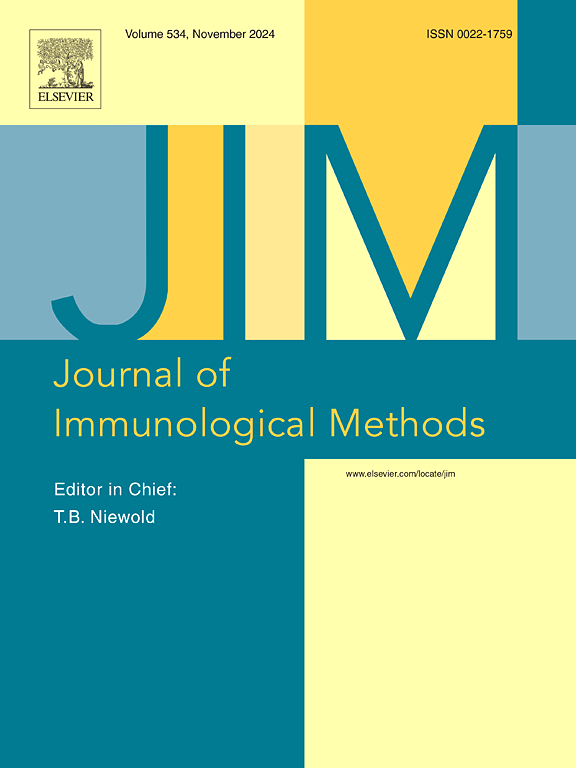Reference intervals for functional lymphocyte proliferation studies using 3H thymidine uptake in adults
IF 1.6
4区 医学
Q4 BIOCHEMICAL RESEARCH METHODS
引用次数: 0
Abstract
Aims
This study aimed to establish the reference intervals for the 3H thymidine uptake assays of functional cellular immunity. Functional tests of cellular immunity play a critical role in several clinical scenarios. An excellent T cell response to vaccine antigens is arguably the best in vitro test of normal cellular immunity.
Methods
In this article the reference intervals for over 250 healthy adults were calculated for lectins, anti-CD3 (OKT3) and antigens comprising Candida, tetanus and diphtheria toxoids. These samples were provided by volunteer blood donors as controls to be run in parallel with diagnostic tests of in vitro cellular immunity in patients with suspected immunodeficiency.
Results
The control samples uniformly responded to PHA. The response to other lectins, OKT3 and antigens was more heterogeneous. The variable responses to diphtheria and tetanus toxoids likely reflected the immunization status of these blood donors to these vaccine antigens.
Conclusions
Although there has been a recent move to implement non-radioactive methods for functional cellular immunity, 3H thymidine uptake continues to be utilized in many diagnostic laboratories because of excellent sensitivity. Robust vaccine-induced cellular responses in immunodeficient patients may inform clinical decisions such as using live attenuated viral vaccines. Similarly, markedly impaired responses to phytohemagglutinin A (PHA), in the appropriate clinical context, supports a diagnosis of Severe Combined Immunodeficiency (SCID) and the need for urgent hematopoietic stem cell transplantation (HSCT). The reference intervals established by this audit will assist other diagnostic laboratories using this platform.
使用成人3H胸腺嘧啶摄取研究功能性淋巴细胞增殖的参考区间。
目的建立功能性细胞免疫3H胸腺嘧啶摄取测定的参考区间。细胞免疫功能测试在几种临床情况下起着至关重要的作用。T细胞对疫苗抗原的良好反应可以说是正常细胞免疫的最佳体外测试。方法计算250多名健康成人的凝集素、抗cd3 (OKT3)和含念珠菌、破伤风和白喉类毒素抗原的参考区间。这些样本由志愿献血者提供,作为对照,与疑似免疫缺陷患者的体外细胞免疫诊断试验同时进行。结果对照样品对PHA反应一致。对其他凝集素、OKT3和抗原的反应更为异质性。对白喉和破伤风类毒素的不同反应可能反映了这些献血者对这些疫苗抗原的免疫状况。结论:尽管最近开始采用非放射性方法检测功能性细胞免疫,但由于3H胸腺嘧啶摄取具有良好的敏感性,因此在许多诊断实验室中继续使用。免疫缺陷患者疫苗诱导的强大细胞反应可为临床决策提供信息,例如使用减毒活疫苗。同样,对植物血凝素A (PHA)的反应明显受损,在适当的临床背景下,支持严重联合免疫缺陷(SCID)的诊断和紧急造血干细胞移植(HSCT)的需要。本次审核建立的参考区间将有助于其他使用本平台的诊断实验室。
本文章由计算机程序翻译,如有差异,请以英文原文为准。
求助全文
约1分钟内获得全文
求助全文
来源期刊
CiteScore
4.10
自引率
0.00%
发文量
120
审稿时长
3 months
期刊介绍:
The Journal of Immunological Methods is devoted to covering techniques for: (1) Quantitating and detecting antibodies and/or antigens. (2) Purifying immunoglobulins, lymphokines and other molecules of the immune system. (3) Isolating antigens and other substances important in immunological processes. (4) Labelling antigens and antibodies. (5) Localizing antigens and/or antibodies in tissues and cells. (6) Detecting, and fractionating immunocompetent cells. (7) Assaying for cellular immunity. (8) Documenting cell-cell interactions. (9) Initiating immunity and unresponsiveness. (10) Transplanting tissues. (11) Studying items closely related to immunity such as complement, reticuloendothelial system and others. (12) Molecular techniques for studying immune cells and their receptors. (13) Imaging of the immune system. (14) Methods for production or their fragments in eukaryotic and prokaryotic cells.
In addition the journal will publish articles on novel methods for analysing the organization, structure and expression of genes for immunologically important molecules such as immunoglobulins, T cell receptors and accessory molecules involved in antigen recognition, processing and presentation. Submitted full length manuscripts should describe new methods of broad applicability to immunology and not simply the application of an established method to a particular substance - although papers describing such applications may be considered for publication as a short Technical Note. Review articles will also be published by the Journal of Immunological Methods. In general these manuscripts are by solicitation however anyone interested in submitting a review can contact the Reviews Editor and provide an outline of the proposed review.

 求助内容:
求助内容: 应助结果提醒方式:
应助结果提醒方式:


